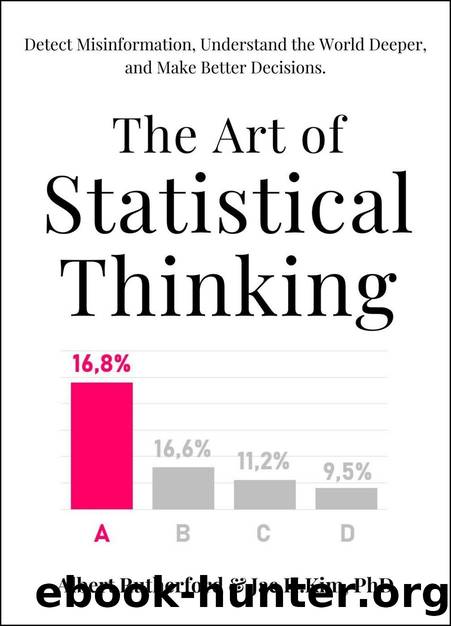The Art of Statistical Thinking by Unknown

Author:Unknown
Language: eng
Format: epub
ISBN: 0000000000000
Published: 2023-04-06T12:06:21+00:00
âNo scientific worker has a fixed level of significance at which from year to year, and in all circumstances, he rejects hypotheses; he rather gives his mind to each particular case in the light of his evidence and his ideas.â
While Fisher did recommend 0.05 as a benchmark threshold for a small sample analysis, it seems he never intended it to be used as a universal threshold. A part of the deep problem we have is this 0.05 threshold recommended for a small sample analysis is still being routinely and mindlessly used in the era of big data.
Neyman and Pearson
The next generation of pioneers were Jersey Neyman and Egon Pearson, who introduced a decision-theoretic approach to hypothesis testing in their paper published in 1933. They introduced the alternative hypothesis in addition to the null hypothesis and concepts such as the level of significance (Type I error rate), statistical power, and Type II error rate. The sample size and the level of significance are critical elements in their method, and they should be chosen before the researcher observes the data. These choices also determine the critical values or critical regions where the researcher accepts the null hypothesis or the alternative hypothesis. Note that âaccepting a hypothesis does not mean that you believe in it, but only that you act as if it were true.â[v][5] According to their teaching, the sample size and the level of significance should be chosen in explicit consideration of the losses or consequences of incorrect decisions.
As we have seen in this chapter, the concepts such as Type I error rate, Type II error rate, and statistical power are important for the paradigm of Neyman and Pearson and largely because it has a substantive alternative hypothesis that specifies the population value we are testing for. This is the point that was different from Fisherâs method and the method being adopted in modern statistics.
In addition, these pioneers recommended inferential statistics as an aid to make the final decision. The inferential outcome should not drive the whole decision process. They recommend being âmodest and thoughtfulâ in making statistical decisions, evaluating the outcome of statistical inference carefully considering all information.
Null ritual
The statistical methods adopted by modern statistical researchers are rather different from the teaching of the above pioneers. It is called âthe null ritualâ by Gigerenzer (2004) in his article, âMindless Statisticsâ. Following his description, the null ritual is conducted in the following way:
Download
This site does not store any files on its server. We only index and link to content provided by other sites. Please contact the content providers to delete copyright contents if any and email us, we'll remove relevant links or contents immediately.
| Allergies | Asthma |
| Autism & Asperger's Syndrome | Cystic Fibrosis |
| Down Syndrome | Eating Disorders |
| Epilepsy | Learning Disorders |
| Lice | Special Needs Children |
I Capture the Castle by Dodie Smith(1579)
Aspergirls by Rudy Simone(1365)
Be Different by John Elder Robison(1334)
Autism's False Prophets by Paul A. Offit(1245)
My Child's Different by Elaine Halligan(1233)
Smart but Scattered—and Stalled by Richard Guare(1198)
101 Tips for the Parents of Boys with Autism by Ken Siri(1157)
What's Making Our Children Sick? by Michelle Perro(1157)
Asperger Syndrome (Autism Spectrum Disorder) and Long-Term Relationships by Ashley Stanford(1118)
ADHD by Mark Selikowitz(1109)
An Adult with an Autism Diagnosis by Gillan Drew(1074)
Girlish by Lara Lillibridge(1072)
Nerdy, Shy, and Socially Inappropriate by Cynthia Kim(1059)
Animal-assisted Interventions for Individuals with Autism by Temple Grandin(1040)
On Immunity: An Inoculation by Biss Eula(1032)
Seeing Ezra by Kerry Cohen(1013)
Overcoming ADHD by Stanley I. Greenspan & Jacob (con) Greenspan(994)
Why Gender Matters by Leonard Sax M.D. Ph.D(984)
Sarah's Child (Hqn Romance) by Linda Howard(983)
